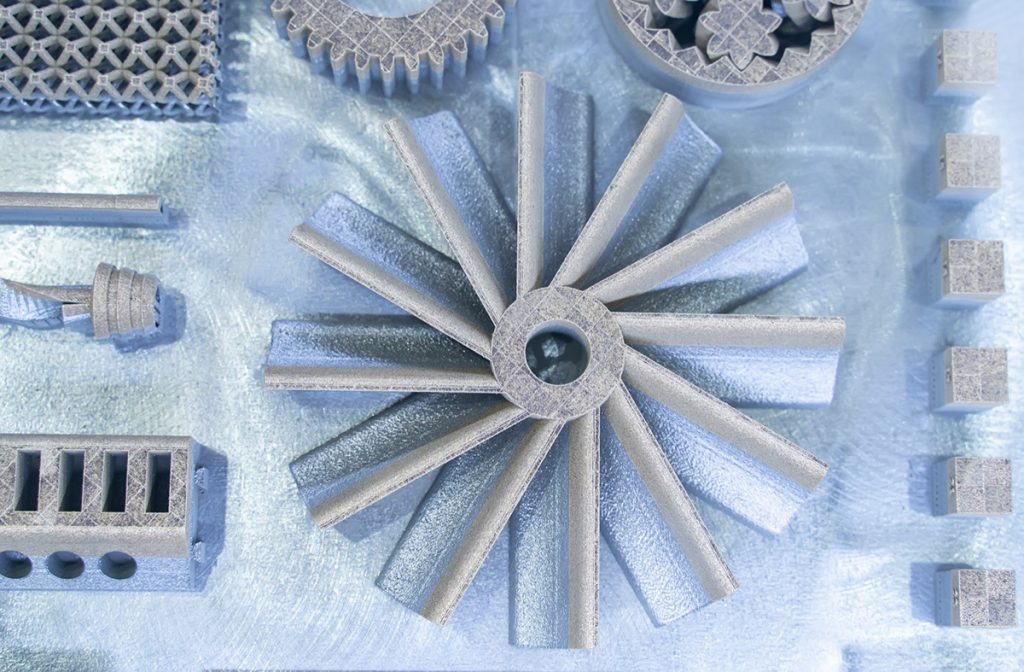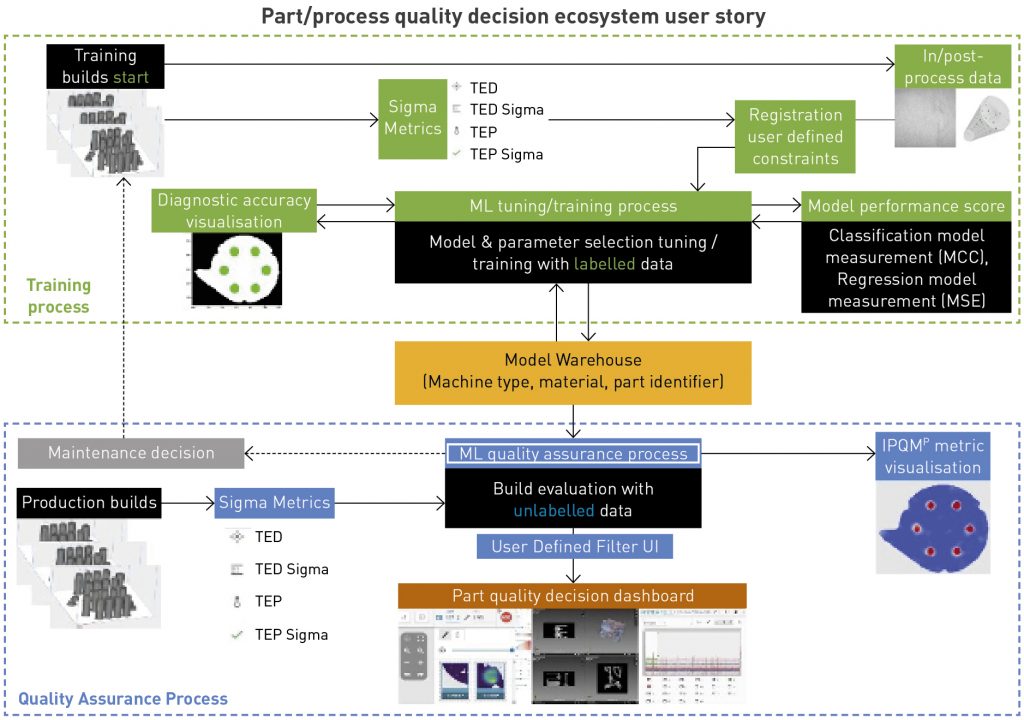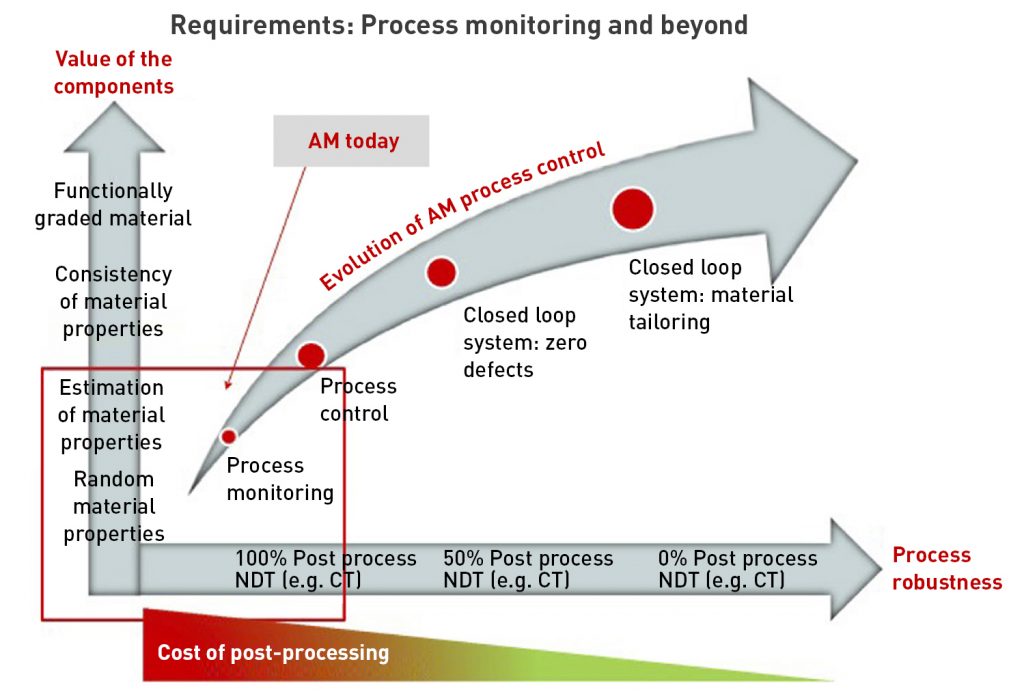Building a case for radical collaboration plus quality standards: The pathway to growing the AM industry
While the acceleration of metal Additive Manufacturing adoption is seen as inevitable, thanks to its advantages over conventional manufacturing processes for high-complexity, customised or on-demand parts, Sigma Labs CEO Mark Ruport believes that 'radical collaboration' is required for AM to reach its true potential. In this article, Ruport discusses how the company is targeting radical collaboration and the implementation of cohesive quality standards across the value chain to grow AM and overcome the challenges posed by true industrialisation. [First published in Metal AM Vol. 7 No. 2, Summer 2021 | 10 minute read | View on Issuu | Download PDF]

I can take no credit for originating the term ‘radical collaboration’. I first heard this phrase several years ago, and it stuck with me because I love the concept of boosting collaboration to the next level. And while our company mission statement and overarching objective is to be the ‘QA standard for Additive Manufacturing,’ I know that our industry and its customers benefit from sharing data and best practices as widely as possible. We also recognise that ‘everyone is smarter than anyone,’ and want to leverage this fact.
When it comes to Sigma Labs, we define radical collaboration as establishing deep relationships with our customers and partners, in both technical and business arenas, to not only ensure our mutual success, but also accelerate growth of the AM industry. We envision doing this by collecting data on the Laser Beam Powder Bed Fusion (PBF-LB) Additive Manufacturing process, measuring that in-situ monitoring data precisely, using that data to create a machine-learning feedback loop that improves both individual part quality and the entire manufacturing process, and making that data available to our customers, partners, and eventually, everyone in the industry. At its core, our objective is to ‘pull the future forward’ by leveraging as much knowledge from as many sources as possible.
In practice, our vision means that when an end-user wants to build a particular series of parts, or a service provider wants to bid on a project, they will have information at hand to determine which types of designs, metals, powders, procedures, etc., are likely to produce the least number of defects and have the highest probability of success. Think of this as creating a catalogue of defect data, supported by best practices in using powder, metals and machines on specific classes of parts. This data is continually refined through manual and machine training, while cycle times are reduced and economics improve through scrap fraction reduction. From an economic and customer satisfaction standpoint, this type of actionable information is invaluable because it leverages critical data and reduces risks. We’ve seen this type of collaboration work well in other industries – for example, in cloud-based software, it is no longer necessary for a vendor to build every component from scratch when tested and proven open-source modules are available to handle significant functions.
When someone asked me recently for an example of where radical collaboration has worked, I immediately thought of YouTube: hundreds of thousands of individuals, companies, educational establishments, trade groups, and others have contributed to a massive knowledge base of how-to information. The more amateurs and professionals post videos, the better the overall quality gets, and the more everyone benefits. The feedback loop is built in, with viewer comments and suggestions. Sigma Labs’ YouTube channel is an example of this, since we have many videos on both narrow-focus and broad topics related on metal Additive Manufacturing quality.
Overcoming AM industry challenges
You may have read articles that discuss a lack of adoption of Additive Manufacturing when it comes to producing end-user parts. Some have even suggested that opportunities for the metal AM industry will remain small in the coming years – and mostly focused on low-volume, highly-customised applications. Perhaps these sceptics have a relevant point to make when talking about the generic Additive Manufacturing marketplace. However, our company, Sigma Labs, as well as others, are involved with a section of the marketplace that has high potential for growth: the industrial mission-critical segment. This includes applications using the most expensive materials and a consistent standard and high quality of individual parts is mandatory. Industries in this segment include defence, aerospace, aviation, transportation, medical, oil & gas, and power generation.
I pointed out one example of this phenomenon in a recent Proactive Investors article. Speaking of the electric vehicle industry: “It was in 1996 when General Motors introduced the EV-1, and, of course, that failed for a lot of different reasons – primarily because of battery life and technology and refuelling, because the infrastructure wasn’t there. It’s a good analogy to what’s happened with 3D metal printing.”
Some twenty-five years later, the technology, the batteries, and the EV infrastructure have finally caught up to the disruptive, revolutionary promise EVs could achieve – and now offer – as the world turns toward clean-energy transportation. Interestingly, there are still plenty of naysayers regarding the EV market, despite the fact that several major automobile manufacturers have promised to go totally electric in the near future, including Jaguar (2025), Volvo (2030) and GM (2035). I predict that some of these EV naysayers will soon become cheerleaders as technologies mature and become mainstream – especially now that Tesla has a market cap of $560 billion, making it worth as much as the next ten automotive companies combined.
While not at the scale of the worldwide automobile industry, I believe metal AM has similarly matured and is poised to usher in a transformative approach to industrial production by creating lighter, stronger, and more durable parts that could not be produced with traditional manufacturing processes. This is the promise of what is now a very exciting industry to be in at a unique point in its history. One of the reasons Sigma Labs is in a good position to spearhead radical collaboration is that we are a third-party agnostic in-process quality assurance (IPQA) solution which works with many different metal AM machine OEMs and materials.
Across this broad spectrum of end-users and industry suppliers, we are in a singular position to collect a tremendous amount of data that can help improve the digital process from design, to simulation, to AM process and post-process steps. We are laying the foundation for our company – plus working with other industry leaders – to leverage our collective learning and create a win-win scenario for individual companies and the entire Additive Manufacturing industry.
“Across this broad spectrum of end-users and industry suppliers, we are in a singular position to collect a tremendous amount of data that can help improve the digital process from design, to simulation, to AM process and post-process steps.”
The Additive Manufacturing parts/process quality ecosystem
Although our primary mission is to focus on AM quality standards, the data we collect supports what we call the Part/Process Quality Ecosystem. As our CTO, Darren Beckett, said in his recent article on the Sigma Labs blog, ‘Machine Learning: A Game Changer for Additive Manufacturing QA’, “Think of the end-to-end part/process quality decision methodology as an ecosystem that functions best if you can distinguish between part and process quality. Effective AM machine learning models are designed to both recognise anomalies in specific parts and monitor the quality of the process itself.”
Fig. 2 shows how the part/process quality ecosystem benefits from a machine learning foundation. Collaboration and quality are closely linked in AM. Since much of the output of AM is mission critical (e.g. space, aviation, auto, medical parts), the stakes to get it right are especially high, both on a micro and macro level. On the micro side, part failure or rebuilds can lead to negative outcomes ranging from increased costs to damaged brand reputations – or, in the case of medical device parts, serious injury or worse. There is a strong imperative to get it right the first time, and every time thereafter. On the macro side, consistent and reliable quality standards will contribute to faster adoption of AM among companies still evaluating AM vs traditional manufacturing methodologies.

We also firmly believe that quality is best measured in-process, not post production. In this argument, we are following in the footsteps of no less an authority than W Edwards Deming, the engineer, statistician, professor, author, lecturer, and management consultant who invented The Deming System of Profound Knowledge. As reported in A Lean Journal, Deming stated: “Inspecting to pull out the failed items from the production before a customer sees them is a path to failure. When companies do this, they are trying to inspect quality into the product. However, 100% inspection has been shown to be only about 80% to 85% effective. If the process is this bad, the process needs to be improved.” And improving the process, not just the inspection, is the real point of radical collaboration.
Cycle time is a sometimes forgotten, but essential, element, of quality. If a company needs to go through five cycles to design, simulate, produce, find defects and conduct post-process measurements, economics suffer far more than if the same results can be achieved in only two or three cycles. With the right data backed up with the right feedback loop, the aircraft can be tested faster, the customised medical device can get to the patient on time, or the rig can get online and producing quicker. These results all have a large positive impact on revenue and company reputation. Of course, a lot of scrap can also be saved with shorter cycles, but that is not the primary benefit.
One of the great benefits of our focus on collaboration is its appeal to different levels of the organisation. On the micro level, it helps the production manager who is evaluated on their efficiency in producing quality parts. On the macro level, collaboration is important to the person in the executive suite who cares about overall output, revenue, profitability and brand reputation.
Creating a feedback loop
Enhanced parts and production performance depend on the feedback loop portion of the machine learning ecosystem. To accomplish this, you feed information in starting at the design and simulation phases, then create a durability analysis that produces a thermal clone of the part you want to produce. The part is then built, and the system monitors the signals during processing. Of all this data is immediately put into the knowledge base and your production team is informed about any inconsistencies between what was simulated and the actual output.
As Fig. 3 shows, if you create your AM environment as an evolutionary process that leverages radical collaboration, the cost of post-processing declines, while the value of the individual process components increases over time. The evolution works even without collaboration, but the benefits are limited. In a collaboration scenario, the manufacturer (plus machine supplier and others) benefits from data that is already in the database and, likewise, contributes data that will help others who will work with the same materials and processes in the future.

Rules for radical collaboration
Radical collaboration sounds great in theory, but I believe there are some steps you need to take and some attitudes you need to embrace, in order to collaborate effectively.
Rule 1: Be intentional
At Sigma Labs we have made radical collaboration one of our core company values and every team member knows how they contribute to making this value a reality. But this is not only true for Sigma Labs. The more this intention is shared across the industry, the more impactful our individual actions will prove to be.
Rule 2: Be radical
To be successful you need to step up your collaboration game – that’s why we use the term ‘radical’ to describe what we are doing. We don’t strive to be just another vendor competing for deals. Of course, we do compete aggressively, but our overarching goal is to achieve real impact for our customers and the entire AM industry.
Rule 3: Measure progress
Like any other objective, what you don’t measure, you usually don’t achieve. The two primary measurement categories of our radical collaboration initiative are, first, the number of end-user manufacturers, industry suppliers and equipment providers who contribute to, and utilise the data, and, second, quantifiable improvements in parts and overall manufacturing processing metrics for individual customers.
Rule 4: Create an actionable knowledge base
I’ve talked about the knowledge base quite a bit in this article because it is a key factor in the success of radical collaboration. Basically, a knowledge base is a consolidated set of data that is organised in such a manner that makes it easy to search, analyse and share. In a business context, the knowledge base needs to facilitate intelligent decision making.
Rule 5: Eliminate information ‘stove pipes’
As defined by Wikipedia, “stove piping, in the context of intelligence, is information created to solve a specific problem that may be presented without proper context…often selectively presenting only that information that supports certain conclusions”. A good example of where shared knowledge beat information stove pipes is the recent rollout of COVID-19 vaccines. Information sharing between pharmaceutical companies, medical research facilities, individual practitioners, and government agencies made a tremendous difference in achieving a speedy and successful rollout of these lifesaving drugs.
Rule 6: Be inclusive
The more entry points of data, the more accurate the system becomes. There is a saying in the data collection industry that the only thing better than big data, is bigger data. There is a concept called ‘sparse data’ where the individual piece of data may not be all that accurate or represent anything like the whole story. However, when you collect thousands or even millions (or billions, in the case of companies like Google) of pieces of sparse data, you create a powerful and accurate knowledge base.
Rule 7: No rule is more important than the mission
Our last and final rule is that no rule should override the goal of achieving radical collaboration. You can’t be ‘radical’ if all you do is follow the rules. Our industry is still fairly young and there are no in-depth blueprints to guide practitioners. As I urge our team and everyone else in the industry: focus on what’s best for the customer and the industry, and do it!
Collaboration in action: DMG Mori and Sigma Labs
A recent collaboration with DMG Mori illustrates the rules mentioned above, reported in that company’s Technology Excellence Magazine concluded that from more simplistic uses such as small-scale component manufacturing to high-stakes applications in medical devices, aerospace, automotive, as well as oil and gas, the technology is a driving force in the innovation of the manufacturing industry.
With increasing significance of Additive Manufacturing, the requirements in terms of quality and productivity are rising, too. Ron Fisher, Business Development at Sigma Labs, was quoted as stating, “In these industries, failure of the final product is simply not an option. Even the most minor inconsistencies in small parts can create dire consequences for end users. For example, a poorly made acetabular cup used in a hip arthroplasty could result in the catastrophic failure of the replacement and extreme pain and suffering for the patient.”
DMG Mori has been meticulous in its dedication to perfection in the QA process. However, the company wanted a QA solution that would allow the operator to have more control during the AM process. Ron Fisher remembers: “While post-process quality control is beneficial in catching errors before they go to end-users, that is really all it can do. Inspection is important, but usually too late to address and prevent problems.” Additionally, post-process QA is time-consuming, expensive and, in many cases, destructive. This is why DMG Mori wanted a QA tool that enables its customers to overcome problems before the final product was complete, saving time and resources and maintaining the company’s standards for helping its users manufacture reliable, proven and safe parts.
The aim of the collaborative effort was to qualify Sigma’s in-process quality assurance (IPQA®) software PrintRite3D® and prepare DMG Mori’s AM machines factory supplied as ‘PrintRite3D Ready’. Specifically, a number of melt pool issues were identified and detected, including lack of fusion and keyhole anomalies using the TEP and TED metrics in conjunction with machine learning models to register and map post process CT data – helpful information for making in-process decisions that can eliminate problem parts before they start to affect other parts on the build plate.
Conclusion
This is just one example of how companies with specialised expertise can come together to create synergy – where one plus one really does equal more than two. Whatever part of the AM industry you represent, I look forward to your participation with our industry’s knowledge base and radical collaboration initiatives. Time will tell whether we are successful in our quest. However, just like the acceleration of metal Additive Manufacturing is inevitable due to its many advantages over traditional processes for the manufacturing of certain high-complexity; customised; or on-demand parts, radical collaboration will be required for AM to reach its true potential. The exciting thing about being part of this initiative is that the potential is only limited by one’s imagination. So, I say to the rest of the industry: Let’s go amaze the world!
Author
Mark Ruport, CEO,
Sigma Labs, Inc.







